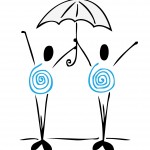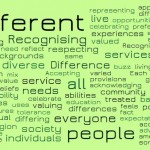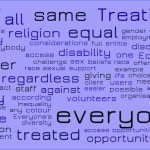Equalities, social justice & human rights
‘Equalities’ is integral to empowering and inclusive ways of working. It’s important that everyone is clear about statutory duties and their responsibility for equalities. This is especially true when there is a need to maximise existing resources, whilst recognising the consequences of reduced services for particular groups within local communities.
and their responsibility for equalities. This is especially true when there is a need to maximise existing resources, whilst recognising the consequences of reduced services for particular groups within local communities.
As well as understanding institutional discrimination, it’s important to recognise that individuals who are in day to day contact with people in communities can exhibit attitudes and behaviours that are discriminatory (consciously or unconsciously) and therefore exclude people.
‘Equalities’ is often seen as difficult and problematic, fraught with the potential to make mistakes, upset and offend people. It doesn’t have to be, nor does it have to involve masses of additional work. To some extent, it’s about recognising and acknowledging that people come from very different places, worlds and life experiences; they have different opportunities, resources and different views. In our society ‘power’ is a very real issue and some have much more power than others!
Whilst you may not be able to change all of these things, on a personal level, the starting point should be a desire to be fair to everyone. You may find yourself in the position of having to balance different priorities and needing to consider the implications of your decisions for different groups of people. At a time when resources are scarce, you need think about how to protect those groups that are already disadvantaged, are most vulnerable and whose voices are rarely heard.
Working in more inclusive ways is likely to involve some personal change and development – at the very least, challenging some ‘commonsense ‘ and maybe long held views which are possibly based on stereotypes and prejudices – your own and other peoples. You probably won’t be able to fundamentally change people’s views and attitudes towards each other – as these are often deep-rooted, likely to come from formative years and be ‘cemented’ in but, you can encourage people to quetion the validity of their views.
You might find it useful to have a look at one of our On The Tin resources, Working in Inclusive Ways – a practical guide for community engagement.
 It’s also useful to acknowledge that some people don’t necessarily subscribe to ‘treating people equally and fairly’ and you may find yourselves in the position of having to deal with some ‘hard issues’ that are raised by the notion of equality and diversity. E.g. religious beliefs about homosexuality; ‘‘immigrants’ are stealing all our jobs’; and, ‘women should know their place’ type views.
It’s also useful to acknowledge that some people don’t necessarily subscribe to ‘treating people equally and fairly’ and you may find yourselves in the position of having to deal with some ‘hard issues’ that are raised by the notion of equality and diversity. E.g. religious beliefs about homosexuality; ‘‘immigrants’ are stealing all our jobs’; and, ‘women should know their place’ type views.
What you can do though, is commit to fairness all round, explore your own views and perceptions, think about how you will deal with prejudice and discrimination and give conscious consideration to the ways that you work.
Although most people now take a commitment to equalities as a given, it’s important that there is something written that encompasses specific values and gives people an idea of how they can know that they are working to the principles.
Why focus on Equality, Diversity, and Discrimination?
Without an understanding of how prejudice and discrimination arise and operate, it is hard to make sure that you work in ways that are inclusive and fair to everyone. It is also hard to challenge others.
It’s all very well having equal opportunities policies – the idea is to be able to put them into practice and make sure that they are meaningful on a day to day basis.
If you employ or manage staff, you will need to make sure that they comply with any legal requirements as well as working in ways that are fair to all.
If you are an employee, you must treat people equally if you don’t want to fall foul of the law or indeed fall foul of your organisation’s equalities policies and practice. You also have a responsibility to be fair to your colleagues and may be held liable for actions which are held to be discriminatory, including bullying and harassment.
What does ‘Diversity’ mean to you?
Diversity is about respecting and valuing difference in a way that adds value to your work with communities. It is also about recognising and understanding the mix of people and groups who use services, focusing attention on their diverse needs and making them central to your work.
Obviously equality and diversity are linked but, it is useful to be aware that while they are sometimes used interchangeably, they emphasise different perspectives. Diversity is about people and equality is about the equality of outcomes experienced by individuals and groups in diverse communities. Equality of outcomes is a requirement of equality law.
Equality is about fairness, not discriminating against individuals or groups because of individual characteristics
The Equality Duty covers: Age, Disability, Gender, Gender Reassignment, Pregnancy and Maternity, Race, Religion or Belief, Sexual Orientation
The duty to have due regard to the need to eliminate discrimination also covers marriage and civil partnerships.
The Equalities Review 2007 recognised that while ‘equality’ as a belief that citizens should be treated as equals is a core principle underpinning many societies, there is much discussion, debate and competing interpretations and perspectives of what this might mean for our society and therefore what it will take to move closer to it. The Review examined the different interpretations in order to arrive at the most appropriate definition that would help in terms of the development of public policy in the 21st century and came up with the following definition:
an equal society protects and promotes equal, real freedom and substantive opportunity to live in the ways people value and would choose, so that everyone can flourish…it recognises people’s different needs, situations and goals and removes the barriers that limit what people can do and can be. Equality is about making sure that people from different groups and communities have the same life opportunities. It is not about treating everyone the same as they may have different needs to achieve the same outcomes.
The Equality Act 2010 replaced previous anti-discrimination laws with a single act to make the law simpler and to remove inconsistencies. One major intention is to make the law easier for people to understand and comply with. It also strengthened protection in certain situations.
The act covers nine specific protected characteristics, which cannot be used as a reason to treat people unfairly. The protected characteristics are: age disability gender reassignment marriage and civil partnership pregnancy and maternity race religion or belief sex sexual orientation
Every person has one or more of the protected characteristics, so the act protects everyone against unfair treatment. However, it also recognises that while there is a case to be made that all of us may be excluded, discriminated against at some point, it may not necessarily be to do with a particular characteristic and that not all ‘unfairness’ is of the same magnitude or significance. Over time, case law will provide a clearer interpretation of how this will work in everyday circumstances.
It is also arguable that there are groups of people who are not included in the list that may be discriminated against or disadvantaged because of a particular characteristic, for example: travellers, homeless people, migrants, ex-offenders and people living in poverty.


